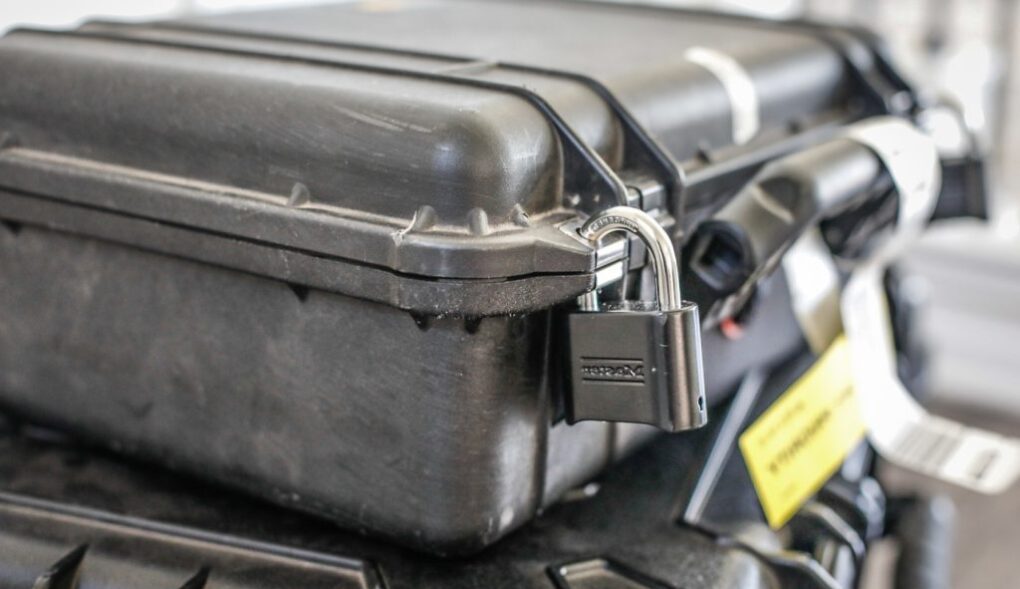The first time I showed up at the airport with my rifle was nerve wracking to say the least. In situations like this, it’s just human nature to assume the worst. I was flying to West Texas for an aoudad hunt and expected someone to yell “GUN!” and be handcuffed at any moment. Luckily though, since I had studied up on the TSA regulations for flying with a rifle before hand, the whole process was a breeze.
I haven’t flown with my gun since that hunt because I almost always hunt with my bow. BTW, flying with your bow is even easier, but much of the same rules apply. However, when the time to fly with a gun arrives again, I’m not too worried about traveling.
A QUICK SUMMARY OF TSA REGULATIONS FOR FLYING WITH A RIFLE
Flying with a firearm legally requires that you follow both airline and TSA rules in the United States, and airline, TSA, and international laws when traveling abroad. Do not take this article as legal advice. We highly suggest that you re-familiarize yourself with TSA’s regulations for Transporting Firearms and Ammunition prior to EVERY trip.
- Your firearms must be unloaded and stored in locked, hard-sided gun cases or containers.
- They can only be stored in checked luggage.
- Firearms must NOT be loaded.
- The owner of the gun must either have a key or combination to the gun case lock.
- Replica firearms, toys, components of firearms, including firing pins, bolts, clips, and magazines must also be in checked baggage.
- Ammunition is prohibited in carry-on luggage.
- Small arms ammunition must be placed in a fiber, cardboard or metal box designed to carry ammunition. This ammunition can be transported in the same hard-sided locked case.
- Check with your airline as to their ammunition limits.
- Declare each firearm in your checked luggage at the desk.
- If you’re traveling abroad, check the laws of the country you’ll be visiting.
THE RIGHT RIFLE CASE & SETUP IS KEY
Choosing the right gun case is essential to avoid being detained by law enforcement or TSA officers. According to the TSA, you can only check in guns and ammunition stored in a hard-sided case. The case should be lockable and capable of completely securing its contents. The lock must not be easy to force open, and only the case owner must have the combination or key to open it.
Don’t bother with a small, single-rifle case because you will be missing out on additional storage space. Using a large, TSA-compliant rifle case allows you travel with less luggage, which saves money on baggage fees. Before purchasing, be sure that the interior is long enough to accommodate the total length of your rifle. That seems obvious, but many hunters have made that mistake.
A hard-sided, tough and durable gun case will protect your firearms and ammunition from the bumps and collisions that will invariably occur during transit. We like the Pelican Vault Cases, and we’ve heard good things about the Seahorse SE1530 Rifle Case as well.
PROTECT YOUR WEAPON IN A SOFT CASE
Most good cases come with some foam layers inside so that you can customize them to your rifle. It seems like a really good idea, but what happens when you get a new rifle, or change out your scope? Instead of using that method, we picked up a tip from Mark Huelsing over at EXO MTN GEAR: He uses a soft rifle case that fits inside of his TSA-compliant hard case. Brilliant idea! Not only does this create more room in the hard case for other gear, but you can also use the soft cast to protect your rifle at your final destination.
On many of our hunts, you will need to catch a bush flight and you can’t take your hard case with you. So having your soft case with you to protect your rifle is a great idea for that purpose as well.
LOAD YOUR RIFLE CASE WITH ALL OF YOUR “RESTRICTED” ITEMS
Don’t just load your case with your rifle and ammunition, especially if you’re going on a hunt. There are plenty of other items that are required to be checked and cannot be in carry-on items with you on the plane. I put trekking poles, knives, binoculars, my spotting scope, fire starting material, etc. in my case along with my rifle, sidearm and ammunition.
Make sure that your ammunition is not “loose packed” in a soft container such as a bag. Ammo cannot be stored within a firearm magazine, even if that magazine is not inserted into the firearm. Pack your ammo in factory boxes or use Ammo Boxes, such as MTM Box.
Once you’ve packed your “restricted” items in the case, be sure to make full use of the rest of the space. I fill the remaining space with my hunting boots and clothes. And I keep adding gear until I’m out of room, ore I’m right up to the 50-pound limit. My goal is always to travel with a maximum of two checked bags (one being my weapon case), and my backpack as a carry on. It is more efficient and I can almost always fit everything I need for a hunt.
AMMUNITION RULES ARE DIFFERENT FOR DOMESTIC AND INTERNATIONAL FLIGHTS
Contrary to popular belief, ammunition DOES NOT have to be packed in a separately locked container from your firearm. That may be true for some international destinations, but not for domestic flights. You can absolutely fly with your ammunition and firearm in the same locked case for domestic flights. If you’re flying out of country, be sure to check the rules for your destination and airline you are traveling with to make sure.
FLYING WITH A RIFLE IS FAIRLY SIMPLE IF YOU FOLLOW THE RULES
When you’re traveling, the last thing you want is to be delayed because you didn’t store your gun properly. Besides being hit with delays, failure to comply with these rules, either on purpose or by accident, could lead to losing your firearm, paying a hefty fine, or even serving jail time. TSA regulations prevent unauthorized access to your weapons at any point in the transit of your luggage. They are designed to protect you and your fellow travelers – not your guns. From the point of view of the TSA, there are no specifically TSA approved cases – only cases that meet their requirements of security.
EXPECT YOUR RIFLE CASE TO BE HANDLED ROUGHLY
The moment your baggage disappears from view, it will most certainly be mistreated. Expect your case to be bumped, knocked, thrown, to be exposed to extreme changes in temperature and pressure, and just a general lack of care. That’s why the rifle case you choose is critical. Not only will having the right case keep you out of trouble, it will protect your firearms and ammunition from being damaged in checked baggage.
TSA WILL REQUIRE THAT YOU LOCK YOUR CASE
You will need a lock to be secured at every possible location on the case. If your case has six latches where a lock could secure the latch to prevent entry, don’t show up at the airport with anything less than six locks.
YOU DO NOT HAVE TO USE TSA-STYLE LOCKS
I used to think that you had to use TSA-approved gun case locks, but this is not the case. The current TSA regulations state that…
“Only the passenger should retain the key or combination to the lock unless TSA personnel request the key to open the firearm container to ensure compliance with TSA regulations. You may use any brand or type of lock to secure your firearm case, including TSA-recognized locks.”
I was happy when I found out that I could use my own padlocks on my firearm case. The idea that TSA had full access to my weapon without me knowing has never appealed to me. So now I never use TSA-style locks. Instead, I use keyed MasterLocks.
AT THE AIRLINE BAGGAGE COUNTER
First, be sure that you have your full name, email and phone number attached to the exterior of your case. It’s probably a good idea to have a few labels as a failsafe. That way anyone who handles the case can reach you directly at any time.
Upon arrival at the airport, head to the airline’s standard baggage counter. Simply state to the agent, “I would like to declare a firearm.”
Most airlines will then have you sign a card stating that you’ve followed TSA’s regulations for checking the firearm. You will then insert that signed card into the weapon case. At this point, your case can be unlocked since the contents of the weapons case need to be checked by a TSA agent.
THERE ARE TWO WAYS TO PROCEED FROM HERE, DEPENDING ON THE AIRPORT
- Sometimes, the baggage counter agent will have you lock the case and give it to them. They’ll then put it right on the standard belt with the rest of the luggage. They’ll then probably ask you to wait 15-20 minutes before going through security. This is just to make sure that TSA doesn’t request access during the screening process. Once your wait is up, you can check back in at the baggage counter to get the OK to go through security and on to your gate.
- The more likely option is they will ask you to take the weapons case directly to the TSA special security screening station. This is usually the same place where oversized baggage is dropped off. The TSA agent will take your case while you wait as the case is checked and screened. Once they have finished their inspection, they’ll ask you to lock the case. Once locked, it is placed on the baggage belt, and you can head to security.
UPON ARRIVAL AT YOUR DESTINATION, YOUR RIFLE CASE WILL NOT COME OUT ON THE BAGGAGE CAROUSEL
Once you’ve retrieved your “regular” checked baggage from the baggage carousel, you’ll need to track down your weapons case. You’ll need to locate the baggage office of the airline that you’ve flown with. Hopefully, there will be an agent there who will check your ID and hand you your case. That’s best case scenario. Pun intended.
Sometimes it doesn’t show up. When this happens you’ll have to work with the baggage agent to figure out where your case is, and when it will arrive. Hopefully this doesn’t happen to you, but it has happened to me with my bow case. Luckily it was AFTER my hunt, and the airline delivered my bow case to my home the next day.
ALWAYS PURCHASE TRAVEL INSURANCE
It’s hard to find insurance companies that will cover your outdoor adventures, including hunting and fishing trips. It’s no wonder because so much can happen when you’re out in the backcountry. But, lucky for you, there are some options for hunters and anglers that will cover your trip should anything happen. I’ve used this service on all of my trips in recent years and have had to use it twice.
I suggest purchasing the Cancel for Any Reason policy, which is about $150 more than other policies. One thing that you need to know is this policy needs to be purchased within 15 days of your deposit being paid. Don’t wait, you could regret it. It’s a hard pill to swallow sometimes, but boy am I glad I’ve had it when needed.
You can learn more and request a free quote here.


